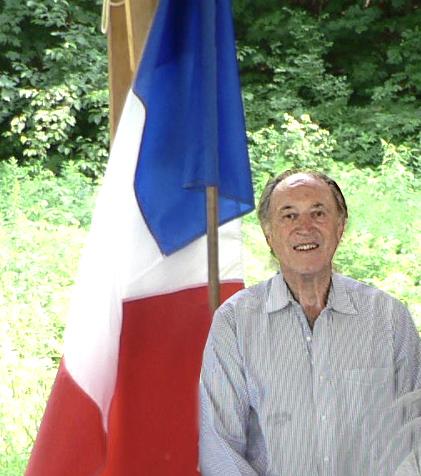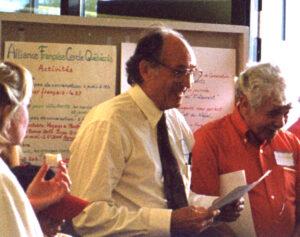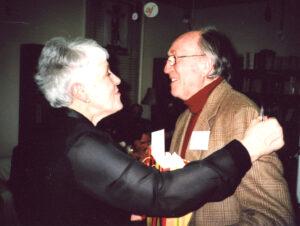Dates: 1928-2015
Hometown in Vermont: Montgomery
Role in AFLCR: Founder and first president; later treasurer, membership coordinator, board member
Frédéric (Eric) Bataille, born in Paris, attended the Collège St.-Croix de Neuilly. After World War II, he served as a lieutenant in the French ski troop, an infantry force trained to operate in mountainous terrain.
In 1952 Eric came to the United States to learn English, married, and had three children. In 1965, living in New York City, he met Anne Greening, who became his second wife in 1967. In 1978 he joined Lalique USA, which imported Lalique crystal objects—perfume bottles, vases, inkwells, bookends, and paperweights—as well as Puiforcat Silver, St. Louis Crystal, and several Limoges porcelain companies. Eric served as executive vice president.
In 1985 Eric and Anne started their own company that represented Lalique, among other luxury products, covering New York State and New England. They moved to Montgomery, Vermont. “We traveled all over New England,” Anne told me, “and took our dogs, and we had great products to sell.” From 1996 to 1999 Eric served as honorary French consul to Vermont and in 1999 was awarded a chevalier in the French Order of Merit.
Eric retired in 1997, although Anne continued until 2000. He took up painting and was active with the local art scene, joining the Bishop Street Artists, and served on the board of the Montgomery Historical Society.
Alliance Française of Vermont–Cercle Québécois
Eric “had a passion for the French language and culture,” Anne Bataille told me. In northern Vermont, several strands of French language and culture converge: a long-ago history of exploration by France; the proximity of Quebec; and the presence of many Franco-Americans, descendants of Québécois immigrants. “It bothered Eric that we were so close to Canada and Quebec, but there was no organization here interested in French language and culture.” While living in New York City, he had frequented a chapter of the Alliance Française, so he was familiar with the organization. “He was a can-do person and said, ‘Let’s do this,’” Anne said. He contacted the AFUSA and got advice on how to form a chapter.
In 1992, along with several colleagues, he incorporated the Alliance Française of Vermont–Cercle Québécois (AFV-CQ) to “encourage French culture.” The name emphasizes the desire to explore the common French, Québécois, and Franco-American heritage.
“His enthusiasm was infectious,” Anne told me. “It really was the force of one man.” He found a number of active and retired French teachers who shared his passion. He brought in Dana and Marc vanderHeyden at St. Michael’s College, and Simon Barenbaum from Middlebury, and Françoise Dehan. In search of further members, he visited the French conversation group Pause-Café, recently co-founded by Linda Pervier. “We were very active and doing a lot of . . . movie nights, lectures, parties,” Pervier later recalled, “and Eric approached us to introduce the idea of reviving the Alliance Française in Vermont and to request our support.”
“One of the great things Eric did,” Anne recalled, “was bring Québécois into Alliance. He had a great admiration for them—how they had survived under adverse conditions and kept their language and culture alive in an English-speaking country.”
The AFV-CQ came together sometime in the mid-1990s—the existing archives start with 1998, so we can’t know exactly. Eric was founder and first president.
At the outset, the group was more for social activities and cultural events than for French classes. The members enjoyed outings together: socializing at potlucks in each other’s homes, observing St.-Jean-Baptiste Day, visiting St.-Jean-sur-Richelieu and other places in Quebec.
Then in 1999 the AFV-CQ began offering classes at the Book Rack in the Champlain Mill: the Book Rack provided the venue and did the advertising, while AF members who were French teachers organized classes (French for Travelers and Advanced Conversation). It was all volunteer—they had no money to pay teachers. Eric kept track of student enrollment, did clerical work, kept the books, and solved problems.
This arrangement lasted till 2001, when the Book Rack withdrew. After that they were unable to replicate that arrangement with another partner, and having no tax-exempt status, they were unable to raise funds. So they returned to the focus on social activities and cultural events.
Alliance Française of the Lake Champlain Region
It turned out that in the late 1980s another organization had used the name Alliance Française of Vermont. That organization had failed, when the director and his wife split up, and the bank account somehow mysteriously vanished. In 2001 that previous director reemerged and sued the AFV-CFQ for using the name Alliance Française of Vermont. With the help of a local attorney, Eric solved the problem by dissolving the AFV-CQ and reorganizing it under a new name, Alliance Française of the Lake Champlain Region. (They chose that expansive name to include colleagues from St.-Jean-sur-Richelieu, two of whom were board members). The group started meeting under that name in April 2002. No wonder Linda Pervier would later refer to Eric affectionately as “Mr. Fixit.”
The group continued to enjoy member events, like monthly French lunches at Chef’s Corner, often followed by games of pétanque; showshoeing to Hazen’s Notch; Bastille Day celebrations at the Batailles’ home; and French Heritage Day. At St. Michael’s College every year they participated in Francophony Week, Haitian Solidarity Week, film screenings, and a Franco Fete. They offered public lectures in a “bag lunch series” at the South Burlington Public Library. When the Greater Paris Children’s Choir, conducted by Francis Bardot, toured North America, Eric organized several performances in our area.
North of the border, in Quebec, they enjoyed cabane à sucre at maple sugaring time. When June rolled around, they celebrated St. Jean Baptiste Day by bicycling along the Chambly Canal to St. Jean, afterward sharing a picnic. They visited vineyards and local produce festivals like the one in Dunham. They toured Montreal art museums, led by Eric, the art lover.
In 2004 Eric resigned as president, but as he did, he asked his colleagues to think long and hard about whether the Alliance could succeed without offering French classes, which was after all the primary mission of Alliance Françaises worldwide, and he urged them “to address the future of French language programs.” Not until 2007-8 would classes come together again, after St. Michael’s College leased the Alliance a space at Fort Ethan Allen for a nominal rent.
In the meantime, after his resignation, Eric continued to serve on the board; he served as treasurer and kept up the membership mailing list. He finally resigned in 2010.
Upon his death in 2015 the board wrote an appreciation for his indispensable role in creating the organization: De l’œuvre d’Eric il nous reste ce beau chapitre de l’Alliance Française, et la responsabilité de perpétuer, en sa mémoire, la culture d’un esprit de communauté amical et élégant à travers le partage de la langue, de l’art de vivre et des plaisirs français. Merci Eric pour ce bel héritage. De là où vous êtes, continuez à nous guider pour continuer votre œuvre si admirablement accomplie.
Or in English : “From Eric’s work we still have this beautiful chapter of the Alliance Française, and the responsibility of perpetuating, in his memory, the culture of a friendly and elegant community spirit through the sharing of language, lifestyle and French pleasures. Thank you Eric for this beautiful legacy. From where you are, continue to guide us to continue your work so admirably accomplished.”
Sources:
AFLCR archives (1998 to 2015)
Anne Bataille, interview by author, October 9, 2022
“Frederic C. Bataille,” obituary, Burlington Free Press, May 1, 2015
Jo Werne, “Lalique Lovers Can’t Get Enough of It,” Chicago Tribune, January 13, 1985.
—Janet Biehl
Tile photo courtesy Anne Bataille; other photos are from the AFLCR archive.


